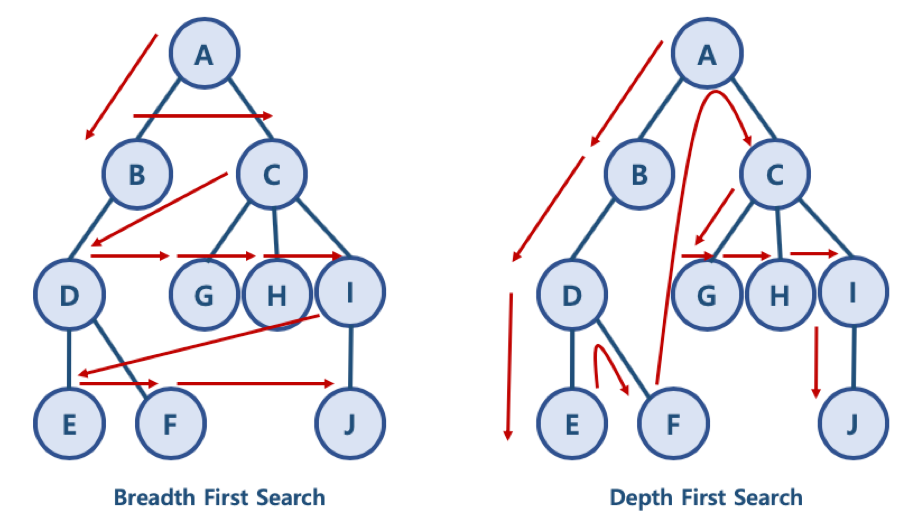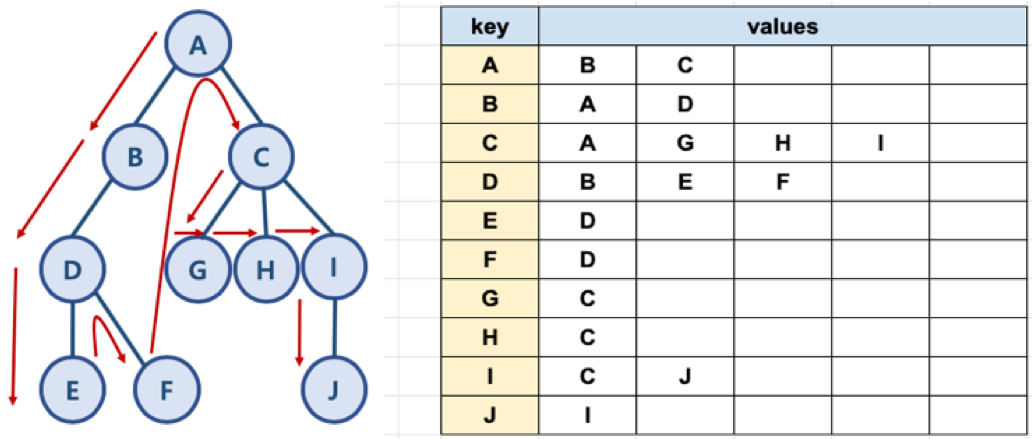깊이 우선 탐색 (DFS)
이해하기 쉽고, 장황하지 않은 자료를 기반으로 강의를 진행합니다.
2. 깊이 우선 탐색 (Depth-First Search)¶
1. BFS 와 DFS 란?¶
- 대표적인 그래프 탐색 알고리즘
- 너비 우선 탐색 (Breadth First Search): 정점들과 같은 레벨에 있는 노드들 (형제 노드들)을 먼저 탐색하는 방식
- 깊이 우선 탐색 (Depth First Search): 정점의 자식들을 먼저 탐색하는 방식
BFS/DFS 방식 이해를 위한 예제¶
- BFS 방식: A - B - C - D - G - H - I - E - F - J
- 한 단계씩 내려가면서, 해당 노드와 같은 레벨에 있는 노드들 (형제 노드들)을 먼저 순회함
- DFS 방식: A - B - D - E - F - C - G - H - I - J
- 한 노드의 자식을 타고 끝까지 순회한 후, 다시 돌아와서 다른 형제들의 자식을 타고 내려가며 순화함

2. 파이썬으로 그래프를 표현하는 방법¶
- 파이썬에서 제공하는 딕셔너리와 리스트 자료 구조를 활용해서 그래프를 표현할 수 있음
In [1]:
graph = dict()
graph['A'] = ['B', 'C']
graph['B'] = ['A', 'D']
graph['C'] = ['A', 'G', 'H', 'I']
graph['D'] = ['B', 'E', 'F']
graph['E'] = ['D']
graph['F'] = ['D']
graph['G'] = ['C']
graph['H'] = ['C']
graph['I'] = ['C', 'J']
graph['J'] = ['I']
In [2]:
graph
Out[2]:
그래프 예와 파이썬 표현¶

3. DFS 알고리즘 구현¶
- 자료구조 스택과 큐를 활용함
- need_visit 스택과 visited 큐, 두 개의 자료 구조를 생성
BFS 자료구조는 두 개의 큐를 활용하는데 반해, DFS 는 스택과 큐를 활용한다는 차이가 있음을 인지해야 함
- 큐와 스택 구현은 별도 라이브러리를 활용할 수도 있지만, 간단히 파이썬 리스트를 활용할 수도 있음
In [3]:
def dfs(graph, start_node):
visited, need_visit = list(), list()
need_visit.append(start_node)
while need_visit:
node = need_visit.pop()
if node not in visited:
visited.append(node)
need_visit.extend(graph[node])
return visited
In [4]:
dfs(graph, 'A')
Out[4]:

4. 시간 복잡도¶
- 일반적인 DFS 시간 복잡도
- 노드 수: V
- 간선 수: E
- 위 코드에서 while need_visit 은 V + E 번 만큼 수행함
- 시간 복잡도: O(V + E)

